Transform CX with AI at the core of every interaction
Unify fragmented interactions across 30+ voice, social and digital channels with an AI-native customer experience platform. Deliver consistent, extraordinary brand experiences at scale.
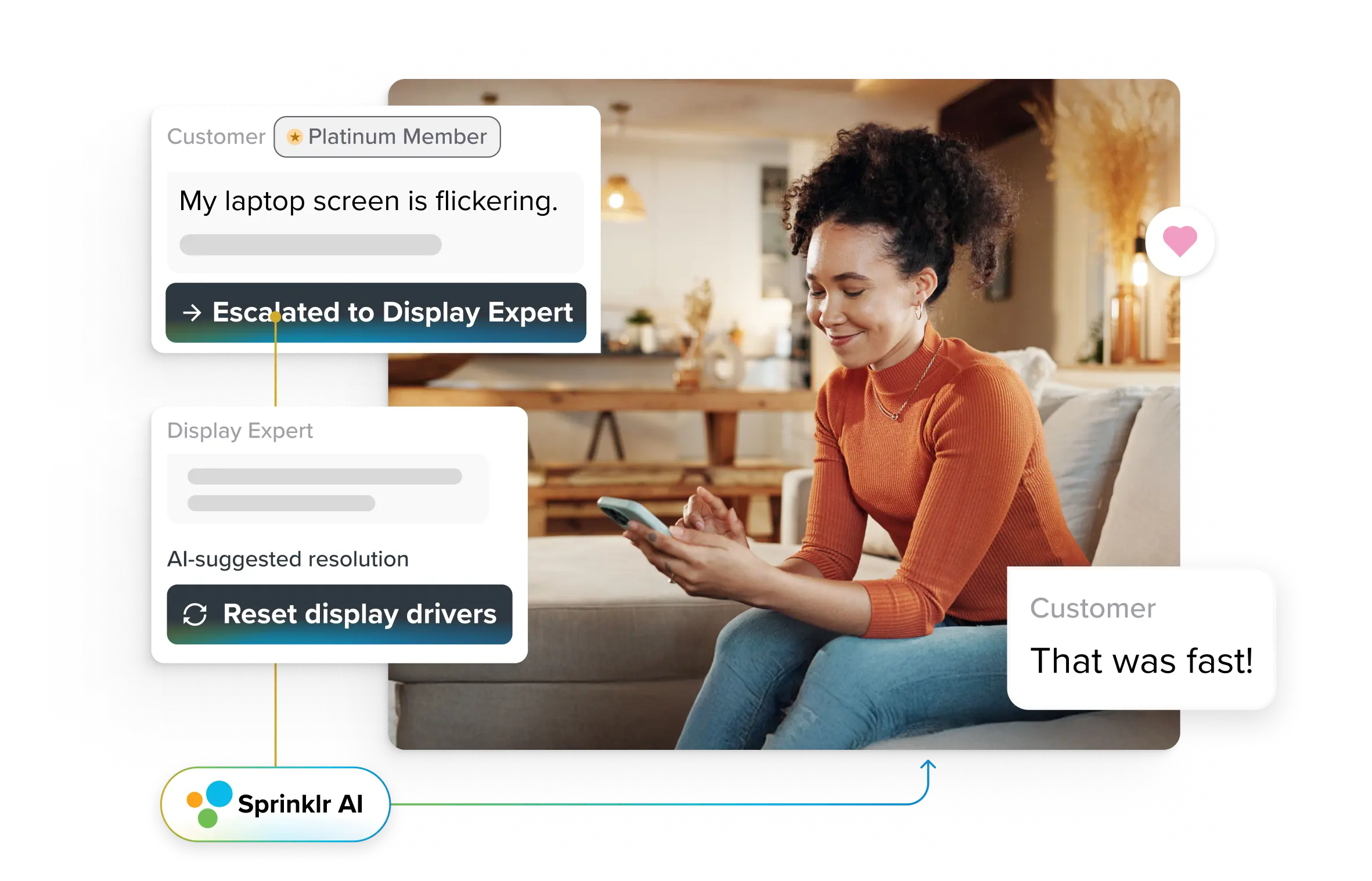
Speech Analytics for Contact Centers: Top 10 Use Cases
Your customers are most expressive when speaking to your agents over a call, rather than when they're on other non-voice channels, such as chat or email.
For your contact center, such candidness could literally result in 20-30% in cost savings, 10% improvement in satisfaction scores, and even stronger sales. BUT, only if you have the correct system in place to analyze 100% of the speech data and utilize it to enhance the customer experience (CX).
So, once your contact center agent hangs up a call with a customer, the real work — analyzing voice — begins! Learn 10 practical ways to apply speech analytics to improve CX.
- What are speech analytics in a contact center — and why are they more than just transcripts?
- Can speech analytics actually work in a contact center in real time?
- 10 Key use cases of speech analytics for contact centers
- Why leaders are doubling down on speech analytics tools for contact centers in 2025
- Unlock incredibly rich contact center insights with Sprinklr's speech analytics software
What are speech analytics in a contact center — and why are they more than just transcripts?
Speech analytics in contact centers is an AI-powered technology that dissects customer conversations beyond mere word transcription.
It analyzes emotional cues, sentiment, tone, pitch, and vocal patterns to extract insights from audio interactions that regular analysis cannot.
Unlike simple transcripts, speech analytics software, for example, identifies customer frustration levels, agent performance gaps, and emerging trends in real-time.
It uses machine learning (ML) and natural language processing (NLP) to identify subtle nuances, such as emotional states, compliance issues, and potential upselling opportunities.
After analysis, your agents can transform raw voice data into voice of the customer intelligence for proactive issue resolution, personalized customer experiences, and data-driven coaching.
As a result, you transform your contact centers from cost centers into profit centers. Data suggests, speech analytics can boost contact center productivity by 40% when done right.
🔥Turn customer voices into delightful experiences with Sprinklr Conversational Analytics Software
Speech analytics focuses mainly on spoken words in voice calls. But your customers are engaging with you in chats, emails, SMSs, social media, etc., with equal, if not more, intensity. A conversation analytics software goes beyond just voice and covers all forms of customer interactions, not just voice.
Analyze 100% of your contact center calls and conversations on every touchpoint using the most advanced AI and get insights on intent, sentiment, and SLAs to improve customer satisfaction by over 200% in under a year.
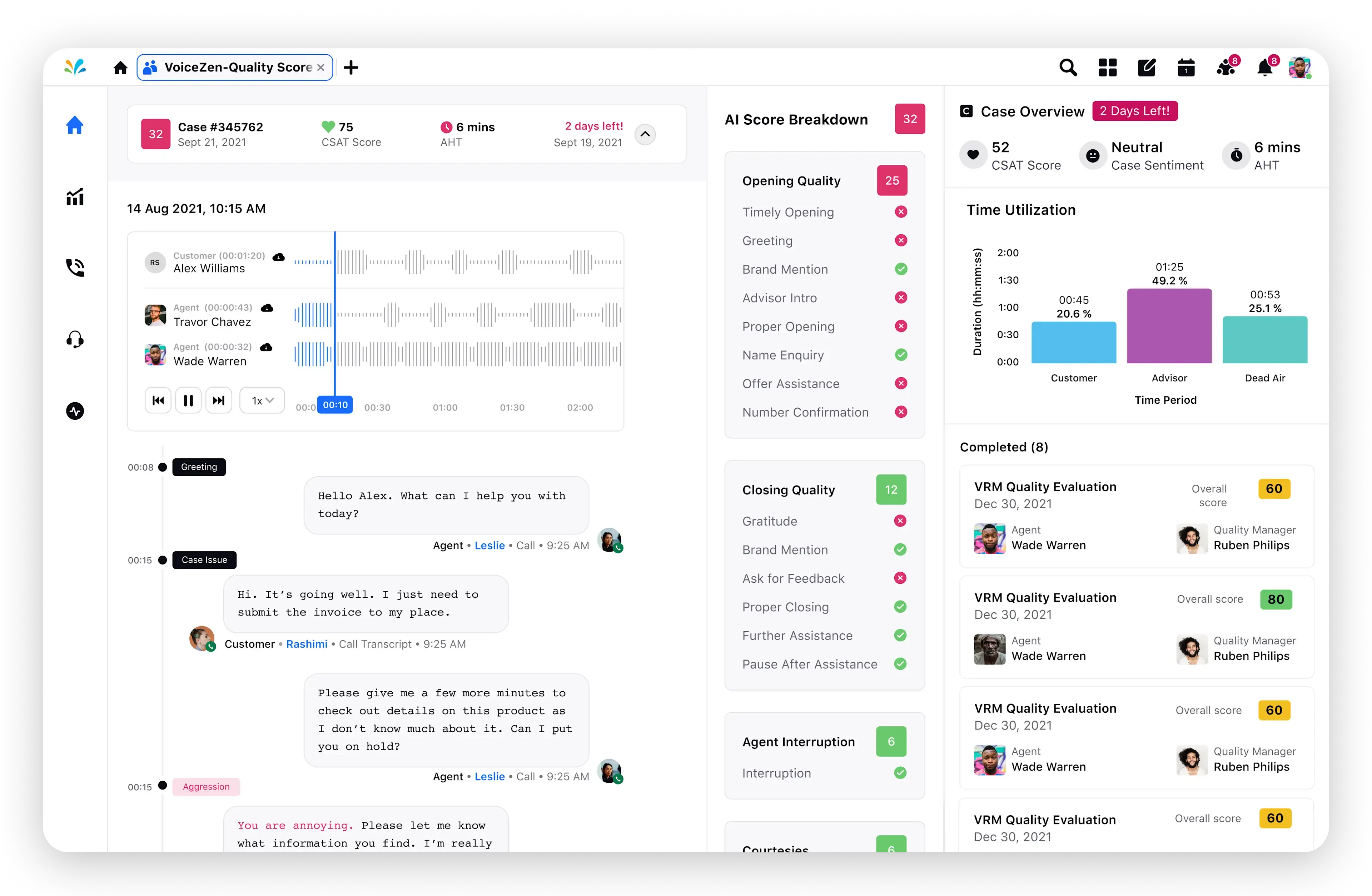
👓 Read more: Customer feedback management: 5-step guide
Can speech analytics actually work in a contact center in real time?
The "real-time" nature of speech analytics is often debated because historically, most systems were post-call, analyzing recordings after the fact.
But yes, real-time speech analytics is now feasible in contact centers, and Sprinklr is one of the vendors making it possible.
Here is a rough overview of how real-time speech analysis features work on a platform like Sprinklr:
- Live sentiment and intent detection - Sprinklr AI+ analyzes tone and keywords in real-time, so agents get alerts like "customer showing frustration"
- Sprinklr Agent Assist prompts agent engagement - Sprinklr AI+ quickly suggests subsequent best actions on-screen: e.g., "Confirm order details" if the system hears ambiguity, or "Escalate to supervisor" if sentiment plunges
- Automated compliance monitoring kicks in - If an agent misses required disclosures ("This call is being recorded for quality purposes"), the system flags it instantly
- Real-time supervisor alerts stay ready for action - Managers see live dashboards with sentiment graphs and alerts (e.g., "three ongoing escalations in queue"), and allow "barge-in" or "whisper" coaching in critical situations
- Generative AI layer is omnipresent - Your agents can use generative AI built into the Sprinklr platform for summaries in real-time, draft follow-ups, and explain scoring decisions to supervisors
- Unified omnichannel view is ready - Sprinklr doesn't treat voice in isolation: speech analytics data merges with chat, email, social, and messaging conversations, giving you a single customer journey view
➕Related read: Customer experience journey: An ultimate guide
10 Key use cases of speech analytics for contact centers
When used effectively, speech analytics can enhance the customer experience and deliver measurable results throughout the organization. Explore key use cases that demonstrate the same:
1. Find emerging compliance risks before audits hit
Regulatory penalties and audit failures can result in millions of dollars in fines, remediation costs, and lost trust.
In highly regulated industries, identifying script deviations or disclosure gaps late in conversations leaves you with little room for prevention.
Consider a bank agent who forgets to mention investment risks during a sales call. Later, regulators discovered this compliance gap during an audit.
As a result, the bank faces fines of $5.2 million for failing to disclose material information, as well as costly remediation programs and damage to customer trust.
Using Sprinklr's Conversational Analytics software, you can automatically detect risky phrases, missed disclosures, and script non-adherence across regions and vendors from voice calls.
You can also set alerts to directly notify compliance and legal teams, enabling teams to act before crisis escalations.
✏️Revisit basics: Contact center compliance: Importance, strategy, and checklist
2. Feed voice of the customer into product and GTM strategy
Imagine a customer calling your support line, saying, "This feature is super confusing — I'm getting frustrated every time I try to use it!"
Surveys often fail to capture the urgency and language customers use to describe their product issues, resulting in delayed fixes and reduced adoption of their feedback.
But a speech analytics software can capture real customer phrases around friction points, feature confusion, demand signals, and flag remarks such as "confusing feature" as a pain point.
For your marketing and product teams, such conversations and the insights can inform roadmap planning, while GTM teams can use this information to refine positioning and messaging based on authentic language.
For example, your product team now knows customers are actively struggling with specific functionality.
Marketing can stop using the term "user-friendly" and instead address the real confusion. Sales teams learn that customers say "frustrating", not "challenging," so they adjust their pitch accordingly.
❓ I am evaluating different speech analytics contact center tools. How do they differ in accuracy when detecting emotional tone vs. compliance issues?
Most speech analytics contact center tools vary in accuracy depending on their core models. But generally, tools that use NLP and verticalized AI tend to perform better:
- Emotional tone detection: Many vendors rely on acoustic cues (pitch, pace, stress), but these can misclassify neutral calls with strong accents or fast speech. Accuracy often drops without a cultural or linguistic context. But platforms like Sprinklr use NLP trained on industry-specific data, with an analysis accuracy of 90%+
- Compliance detection: Tools are generally stronger in this area as compliance relies on keyword/phrase spotting (e.g., "disclosures,” “opt-outs”); however, it can still miss nuance when agents paraphrase. On Sprinklr, Parameter Builder lets you define and fine-tune rules (e.g., greetings, disclaimers, regulatory phrases), so you can tailor AI-scored compliance checks to your needs
3. Standardize QA across multi-vendor ecosystems
Maintaining consistent service quality across internal, outsourced, and hybrid contact centers often results in uneven experiences and compliance risks.
Traditional sampling-based quality assurance (QA) fails to capture the entire picture, leaving blind spots that allow vendor gaps, angry customers, and compliance violations to persist in the shadows.
Imagine a luxury hotel chain where some locations deliver five-star service while others feel like budget motels.
Your internal team knows the brand perfectly but struggles with technical issues. Your outsourced vendor in Manila excels at troubleshooting but misses cultural nuances.
Meanwhile, your QA team only checks 2% of calls, like a food inspector visiting just one restaurant per month.
A speech analytics software like Sprinklr gives 100% QA coverage for every single call to and from your contact center by automatically analyzing every interaction across all vendor ecosystems.
As a result, you can benchmark behaviors such as empathy, resolution effectiveness, and tone to identify performance gaps, replicate best practices, and escalate those that require training.
⚡Pro tip: Track quality consistently across multiple teams by moving away from scattered reviews and manual scorecards. Use Sprinklr's AI-powered quality management tool to automatically generate agent-level quality and provide supervisors with detailed dashboards for performance comparison.
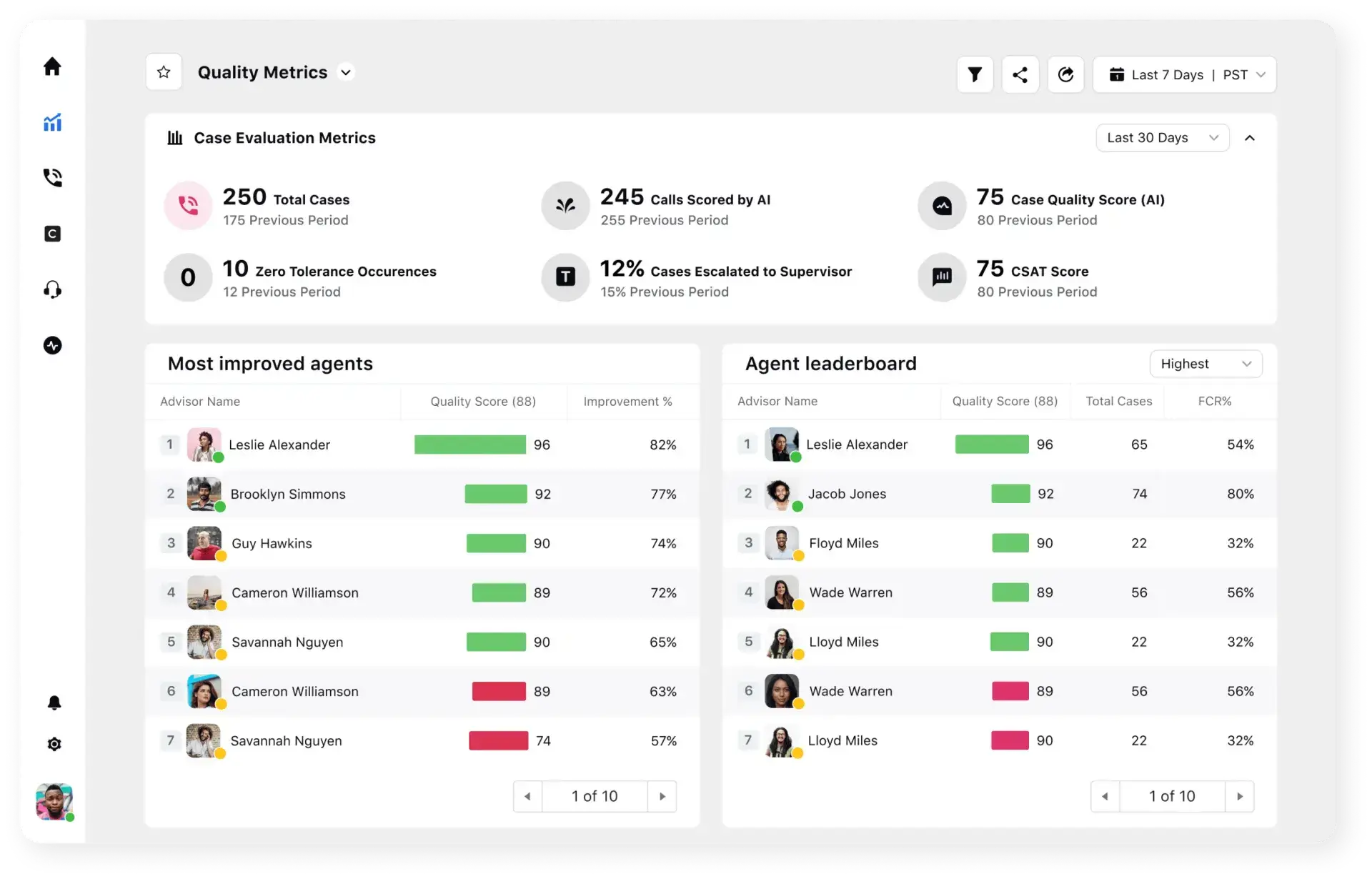
4. Predict churn risk in high-value customer segments
Your high-value customers often provide early signals of dissatisfaction in calls, like subtle tone shifts, rising frustration, or specific language cues that traditional monitoring can miss.
Emotion and sentiment scoring in Sprinklr flags frustration markers, tone shifts, and negative phrasing in real-time, sans human intervention.
You can use this data to route at-risk accounts to top-performing retention agents within minutes.
For example, Cdiscount, a French e-commerce giant, utilized Sprinklr's speech and text analytics to transcribe/analyze voice, chat, and social media data.
They analyzed 100% of the voice calls and identified key themes (e.g., delivery/refunds), enhanced agent training, triggered alerts for sensitive interactions, and even uncovered process bugs.
One of the outcomes of Cdiscount's speech analysis was a payment issue affecting approximately 12,000 customers, and they also achieved a CSAT increase of over 15%.
Studies show that applying speech analytics in this manner can increase customer satisfaction scores by up to 10%, transforming early intervention into a measurable competitive advantage.
“We want our customers to feel heard and supported. Sprinklr provides us with a unique platform that allows us to improve each customer experience while giving our agents the opportunity to become top performers. Our vision is to integrate 100% of our contact channels into the Sprinklr platform by integrating contact forms, social networks, messaging and chat, and industrialize the integration of Sprinklr into our quality and training processes.”
— Louis Brun-Ney, Director of Customer Service, Cdiscount
👌You may like: Predictive analytics in customer service
5. Improve capacity planning with voice-driven forecasting
Forecasting future call volumes is often a time-consuming and error-prone process, especially when conducted manually.
Your workforce planners may struggle to accurately anticipate demand shifts, leading to SLA breaches during call center spikes or wasted resources during lulls.
Speech analytics with AI uncover demand signals by analyzing historical call patterns and monitoring shifts in sentiment.
You can use these insights to identify early indicators of surges — whether seasonal upticks or crisis-driven spikes — so your teams can adjust capacity with precision, rather than relying on guesswork.
⚡Pro tip: Use real-time voice signals to make scheduling decisions and prevent overstaffing, burnout, and missed service levels.
Sprinklr's Workforce Management tool can help your workforce planners merge speech-derived demand indicators with AI-driven forecasting to test scenarios, such as shrinkage, changes in average handle time, or occupancy shifts.
Your supervisors also gain live adherence monitoring, tracking logins, breaks, and deviations in real time to keep operations balanced and efficient.
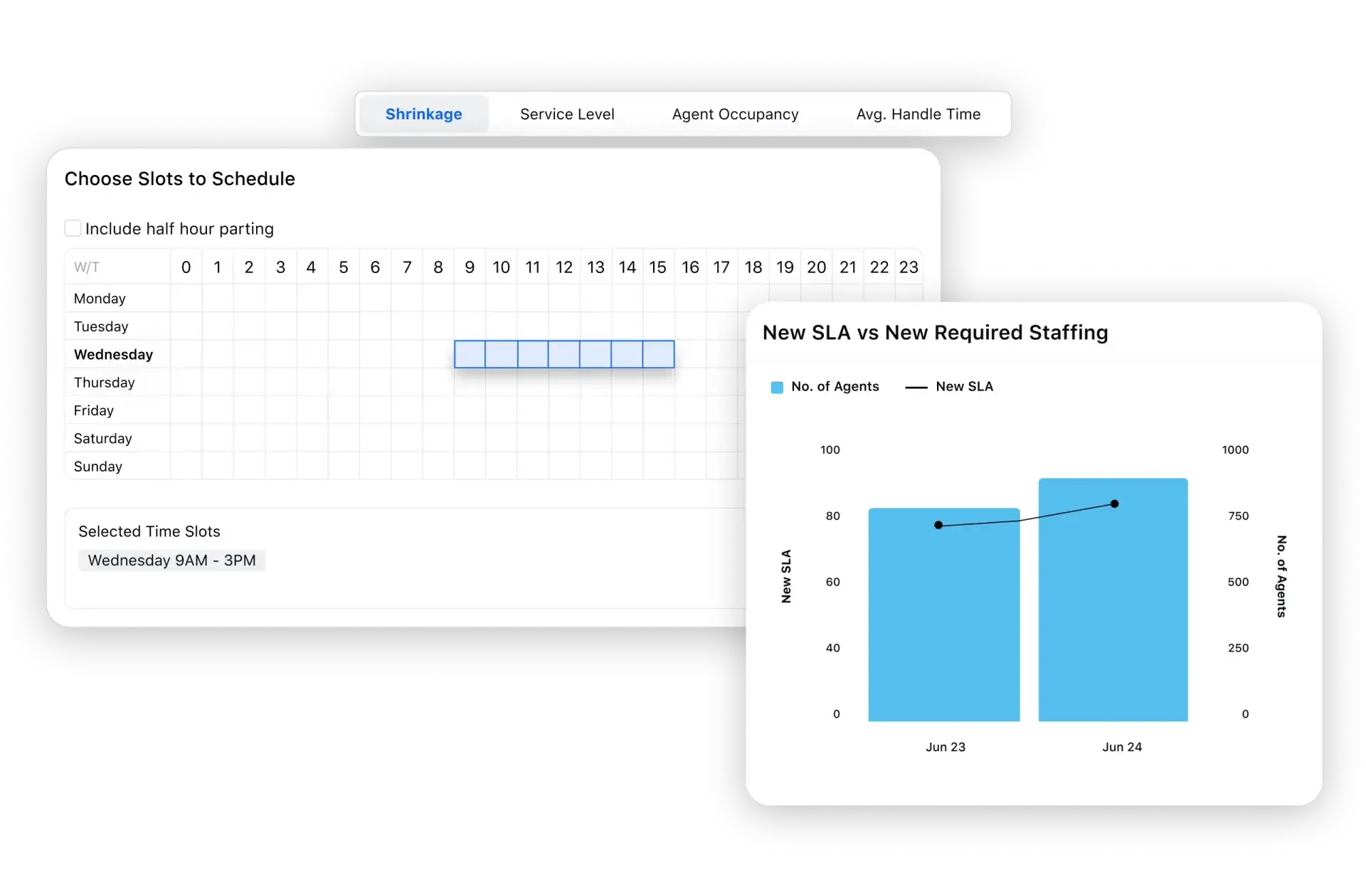
You can also streamline workflow efficiency through Sprinklr's Jira integration and achieve 99.9% SLA compliance by tracking SLA metrics and performance.
6. Detect PR risks and reputational threats early
While capacity planning ensures operational readiness, you also need to anticipate shifts in customer sentiment during calls that can impact brand perception.
Unseen dissatisfaction in calls can quickly escalate into public relations issues if you cannot identify and address them early enough.
Speech analytics software monitors 100% of your call center conversations for early warning signs. It then surfaces these signals before they trend on social media.
Your marketing and communications teams can adjust messaging or issue preemptive statements to effectively manage the narrative.
❓ I want to understand how speech analytics and contact center capabilities can support broader automation initiatives within the enterprise
Here are some ways how a speech analytics software like Sprinklr can help you with broader automations in your enterprise:
- Real-time speech analytics: Transcribes and analyzes every voice call (85%+ accuracy in 20+ languages), identifies sentiment, trends, root causes, and generates AI-driven “next-best actions”
- Smart Alerts and Agent Assist: Triggers supervisor alerts during live calls (e.g., low predicted CSAT or SLA misses) and provides real-time guidance to agents
- Conversational AI + automation: Uses generative-AI insights to automate workflows, improve quality (autoscoring), drive follow-up actions, and create dynamic dialog flows
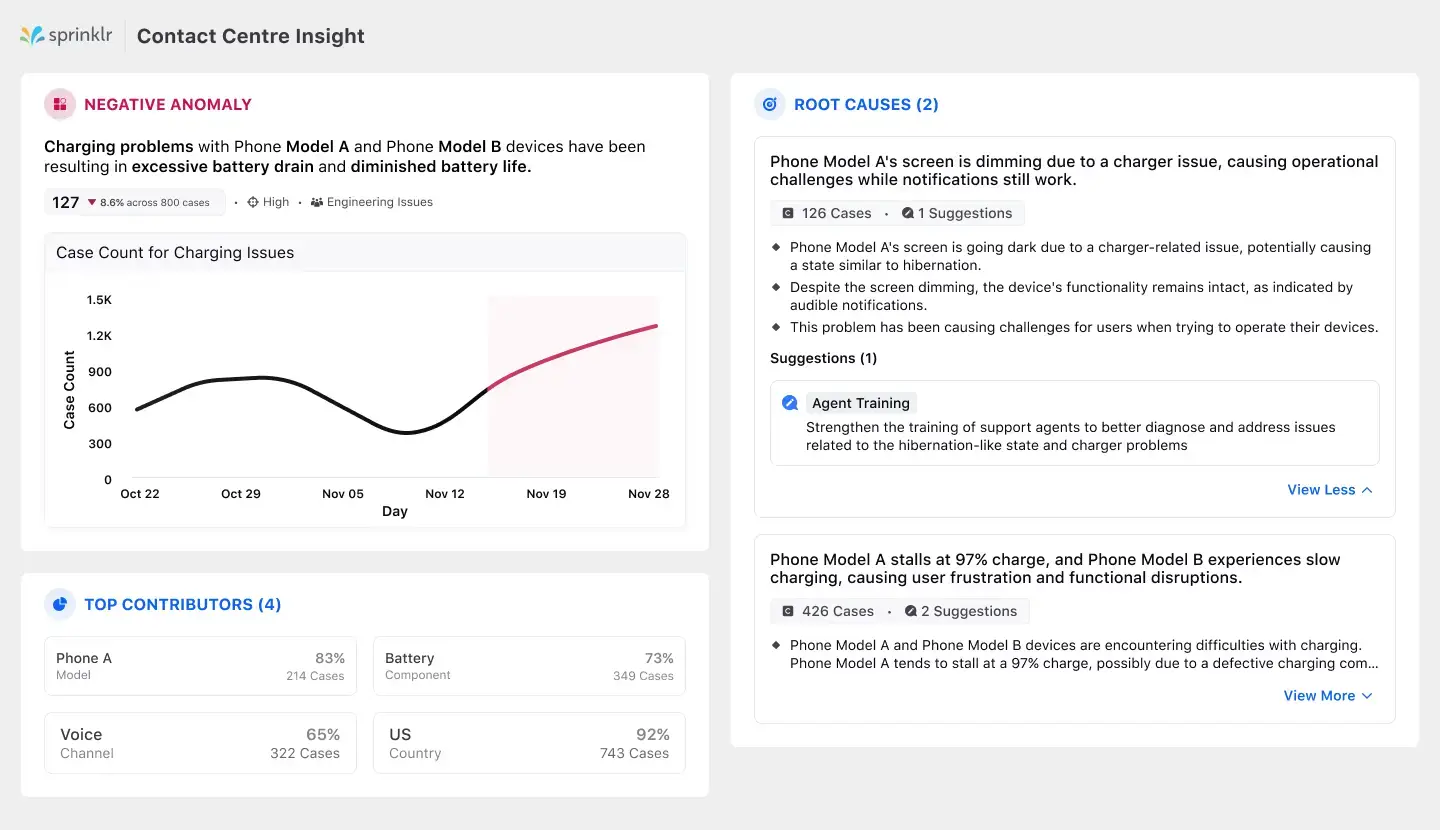
➕Related read: How to detect PR crises in real time and proactively resolve them
7. Reduce cost-to-serve with speech-driven root cause analysis
Your operations teams may struggle to understand why customers keep calling back, face long wait times or leave issues unresolved.
Traditional call center metrics often fail to reveal the underlying causes, making it challenging to improve efficiency and control costs.
Speech analytics examines real conversations and pinpoints the root causes behind repeat calls, extended handle times, or unresolved issues.
For example, the Call Level Analytics report on Sprinklr captures critical case-level analytics on every voice call and presents a detailed report on contact drivers, sentiment, and predicted CSAT scores for specific call attributes, including noise, volume, speech rate, dead air time, and more.
With this evidence, your operations leaders can redesign workflows, refine processes, and proactively address areas for improvement.
Even modest improvements in first-call resolution (FCR) yield big payoffs: a 1% FCR gain can elevate NPS by 1.4 points and provide $286,000 in annual savings for a midsize center.
8. Train enterprise AI models using high-fidelity voice data
After identifying and resolving operational inefficiencies, you may want to scale solutions through automation.
AI systems, such as IVR flows, chatbots, and virtual agents, frequently struggle with unresolved queries or unnatural interactions due to the lack of real-world voice data. For example, your chatbot may sound robotic, prompting customers to hang up in frustration.
Alternatively, your IVR system may transfer callers endlessly because it struggles to understand regional accents or emotional cues.
Speech analytics data acts like a training coach to your CcaaS platform, listening to thousands of real conversations between customers and your best human agents.
It catches subtleties — when agents use humor to defuse anger, how they handle confused elderly customers, or which phrases actually solve problems.
You can utilize this real-world intelligence to train your AI to sound human, respond naturally, and genuinely assist customers, rather than driving them away.
9. Support post-crisis analysis with speech-grounded evidence
Your contact center will likely face unexpected crises, such as those triggered by product recalls, data breaches, or service outages. In such cases, you will anticipate a spike in queries.
Understanding customer sentiment over time is important in those situations to prevent negative sentiments from spiraling out of control. It is also essential to have compliant records of any conversations you've had with customers during a crisis escalation.
For example, when a customer complaint escalates to legal action or goes viral on social media, you will need concrete proof of what actually happened.
Instead of relying on agent notes that say "customer was satisfied," you can pull the exact audio snippet where the customer says, "Thank you, that solved my problem perfectly."
This speech evidence transforms “he-said-she-said" disputes into clear, indisputable facts, protecting your company with the customer's own recorded words as your defense.
The best part? On platforms like Sprinklr, 100% conversations have a sentiment score. So, instead of manually sifting through hours of recordings, sentiment analysis instantly flags emotional turning points — exactly when a customer shifts from frustrated to satisfied, or when an interaction goes from neutral to hostile.
You can also utilize this data to tailor interventions, develop targeted recovery strategies, and communicate transparently with stakeholders and investors.
➕Related read: How generative AI is transforming crisis management
10. Localize CX strategies through regional speech segmentation
Customer language, tone, and emotional cues differ significantly across regions.
Here's an example of two conversations about slow internet services, the first one by a Southern customer and the second by a New Yorker:
· "Y'all better fix this mess real quick now, bless your heart, 'cause I'm fixin' to lose my mind over here!"
· "Listen, this service is absolutely brick. You gotta schlep over here and fix this thing today!"
Note the variation in conversations. If you rely only on traditional contact center metrics to personalize CX, such data makes it challenging to deliver relevant, culturally attuned experiences.
But speech analytics software will use AI/ML to interpret the Southern caller's elongated vowels and polite-but-firm language, and the New Yorker's rapid speech with direct, urgent phrasing.
Ultimately, it will tell you that both customers are equally frustrated and provide a clue that their cultural communication styles require different response approaches.
You can use these insights to tailor training programs, customize agent scripts, and adapt workflows for each market, ensuring interactions feel authentic and resonate locally.
Why leaders are doubling down on speech analytics tools for contact centers in 2025
CcaaS leaders are doubling down on speech analytics because the ROI is undeniable. Here's why this technology has become non-negotiable for contact centers in 2025:
Proven performance impact
McKinsey data shows that contact centers implementing speech analytics achieve a 10% improvement in customer satisfaction scores.
Real-world results include Telefónica, which transformed its service operations with Sprinklr's Speech Analytics software.
Conversational AI platform built in Sprinklr now handle outbound campaigns across various channels, including voice and WhatsApp, reducing Telefónica's manual workload.
AI Agent Assist provides live suggestions to agents, while supervisor whispering allows managers to coach discreetly during calls.
What's more, Telefónica's regional teams now analyze 100% of customer interactions, uncovering:
- Performance differences across BPO partners
- Sentiment shifts and campaign effectiveness
- Compliance and customer experience trends
Operational necessity
The correct speech analytics software will automatically transcribe 100% of conversations, eliminating the guesswork in quality assurance.
The Department of Digital Ajman, Government of the UAE, for example, utilizes Sprinklr's AI-powered voice sentiment analysis to detect frustration/escalation during calls.
Sprinklr's AI alerts supervisors in real-time for on-call coaching and de-escalation as part of an omnichannel contact center modernization.
You can use a similar approach to identify compliance issues, monitor sentiment, and detect emerging trends in real-time. This is operational survival in today's competitive landscape.
AI-powered automation
A 2023 Gartner survey revealed that contact center leaders spend excessive time on administrative tasks rather than strategic action.
Modern speech analytics platforms, such as Sprinklr, come with built-in AI-powered insights, automated quality assurance, and integrated performance management.
These capabilities free your contact center teams to focus on what matters: delivering a great customer experience and fostering team development.
Competitive advantage
With the ability to detect competitor mentions, unmet needs, and emerging market trends, speech analytics provides the intelligence needed to pivot faster than competitors.
In the fast-paced market of 2025, this real-time competitive intelligence is the difference between leading and following.
The evidence is clear: leaders aren't investing in speech analytics as a nice-to-have — they're doubling down because it directly impacts their bottom line.
Unlock incredibly rich contact center insights with Sprinklr's speech analytics software
Speech analytics is no longer just a QA tool. It's a growth driver for revenue, retention, and customer experience that elevates your entire contact center.
Adoption will look different across industries and maturity levels: some will focus on compliance monitoring, while others push into churn reduction, upselling, or personalized coaching.
Sprinklr's Conversational Analytics Software turns speech intelligence into action. And because Sprinklr Service unifies voice, social, and digital insights in a single dashboard, you can break down data silos, act on real-time alerts, and embed insights directly into CRM, knowledge, and workforce tools.
Ready to see how speech analytics can transform your contact center? Book a free demo today and experience the future of customer engagement.
Frequently Asked Questions
Speech analytics focuses on voice interactions, capturing tone, emotion, and pacing, while chat analytics analyzes text-based conversations. Voice data provides a richer context for understanding customer intent and sentiment that text alone may miss.
These tools can analyze inbound and outbound calls, support escalations, and agent-to-agent conversations. They also capture multi-vendor or hybrid call interactions for consistent evaluation.
Yes, advanced speech analytics tools can detect sentiment, emotion, and speech patterns in real-time as calls occur. This enables agents and supervisors to respond promptly and improve customer experience on the spot.
Managers can track call trends, agent performance, sentiment scores, compliance adherence, and escalation triggers. These insights help identify training needs, optimize workflows, and enhance overall contact center efficiency.
Yes, supervisors can provide live guidance using prompts or alerts during calls. This ensures agents stay on script, handle issues faster, and maintain consistent service quality.









